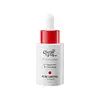What's inside
What's inside
 Key Ingredients
Key Ingredients

 Benefits
Benefits

 Concerns
Concerns

 Ingredients Side-by-side
Ingredients Side-by-side

Water
Skin ConditioningButylene Glycol
HumectantDipropylene Glycol
HumectantNiacinamide
Smoothing1,2-Hexanediol
Skin ConditioningGlycerin
HumectantPanthenol
Skin ConditioningGlycereth-26
HumectantHydroxyethylcellulose
Emulsion StabilisingErythritol
HumectantSodium Polyacryloyldimethyl Taurate
Emulsion StabilisingSodium Hyaluronate
HumectantAllantoin
Skin ConditioningEthylhexylglycerin
Skin ConditioningCaprylic/Capric Triglyceride
MaskingBiosaccharide Gum-1
HumectantDisodium EDTA
Hydrogenated Lecithin
EmulsifyingBetaine Salicylate
AntimicrobialSuccinic Acid
BufferingTromethamine
BufferingSaccharomyces Ferment Filtrate
HumectantOctyldodecanol
EmollientPolyglyceryl-10 Laurate
Skin ConditioningPhosphatidylcholine
EmulsifyingAsiaticoside
AntioxidantCentella Asiatica Leaf Extract
Skin ConditioningMadecassic Acid
Skin ConditioningAsiatic Acid
Skin ConditioningGlycolipids
Skin ConditioningCeramide NP
Skin ConditioningBeta-Glucan
Skin ConditioningLactobacillus Ferment
Skin ConditioningLactobacillus/Soybean Ferment Extract
Skin ConditioningLeuconostoc/Radish Root Ferment Filtrate
AntimicrobialYeast Ferment Extract
Skin ConditioningPalmitoyl Tripeptide-5
Skin ConditioningAlbatrellus Confluens Extract
HumectantMadecassoside
AntioxidantCentella Asiatica Extract
CleansingHydroxypropyltrimonium Hyaluronate
Tocopherol
AntioxidantZinc PCA
HumectantHexapeptide-9
Skin ConditioningWater, Butylene Glycol, Dipropylene Glycol, Niacinamide, 1,2-Hexanediol, Glycerin, Panthenol, Glycereth-26, Hydroxyethylcellulose, Erythritol, Sodium Polyacryloyldimethyl Taurate, Sodium Hyaluronate, Allantoin, Ethylhexylglycerin, Caprylic/Capric Triglyceride, Biosaccharide Gum-1, Disodium EDTA, Hydrogenated Lecithin, Betaine Salicylate, Succinic Acid, Tromethamine, Saccharomyces Ferment Filtrate, Octyldodecanol, Polyglyceryl-10 Laurate, Phosphatidylcholine, Asiaticoside, Centella Asiatica Leaf Extract, Madecassic Acid, Asiatic Acid, Glycolipids, Ceramide NP, Beta-Glucan, Lactobacillus Ferment, Lactobacillus/Soybean Ferment Extract, Leuconostoc/Radish Root Ferment Filtrate, Yeast Ferment Extract, Palmitoyl Tripeptide-5, Albatrellus Confluens Extract, Madecassoside, Centella Asiatica Extract, Hydroxypropyltrimonium Hyaluronate, Tocopherol, Zinc PCA, Hexapeptide-9
 Reviews
Reviews

Ingredients Explained
These ingredients are found in both products.
Ingredients higher up in an ingredient list are typically present in a larger amount.
Niacinamide is a multitasking form of vitamin B3 that strengthens the skin barrier, reduces pores and dark spots, regulates oil, and improves signs of aging.
And the best part? It's gentle and well-tolerated by most skin types, including sensitive and reactive skin.
You might have heard of "niacin flush", or the reddening of skin that causes itchiness. Niacinamide has not been found to cause this.
In very rare cases, some individuals may not be able to tolerate niacinamide at all or experience an allergic reaction to it.
If you are experiencing flaking, irritation, and dryness with this ingredient, be sure to double check all your products as this ingredient can be found in all categories of skincare.
When incorporating niacinamide into your routine, look out for concentration amounts. Typically, 5% niacinamide provides benefits such as fading dark spots. However, if you have sensitive skin, it is better to begin with a smaller concentration.
When you apply niacinamide to your skin, your body converts it into nicotinamide adenine dinucleotide (NAD). NAD is an essential coenzyme that is already found in your cells as "fuel" and powers countless biological processes.
In your skin, NAD helps repair cell damage, produce new healthy cells, support collagen production, strengthen the skin barrier, and fight environmental stressors (like UV and pollution).
Our natural NAD levels start to decline with age, leading to slower skin repair, visible aging, and a weaker skin barrier. By providing your skin niacinamide, you're recharging your skin's NAD levels. This leads to stronger, healthier, and younger looking skin.
Another name for vitamin B3 is nicotinamide. This vitamin is water-soluble and our bodies don't store it. We obtain Vitamin B3 from either food or skincare. Meat, fish, wheat, yeast, and leafy greens contain vitamin B3.
The type of niacinamide used in skincare is synthetically created.
Learn more about NiacinamideSodium Hyaluronate is hyaluronic acid's salt form. It is commonly derived from the sodium salt of hyaluronic acid.
Like hyaluronic acid, it is great at holding water and acts as a humectant. This makes it a great skin hydrating ingredient.
Sodium Hyaluronate is naturally occurring in our bodies and is mostly found in eye fluid and joints.
These are some other common types of Hyaluronic Acid:
Learn more about Sodium HyaluronateWater. It's the most common cosmetic ingredient of all. You'll usually see it at the top of ingredient lists, meaning that it makes up the largest part of the product.
So why is it so popular? Water most often acts as a solvent - this means that it helps dissolve other ingredients into the formulation.
You'll also recognize water as that liquid we all need to stay alive. If you see this, drink a glass of water. Stay hydrated!
Learn more about Water